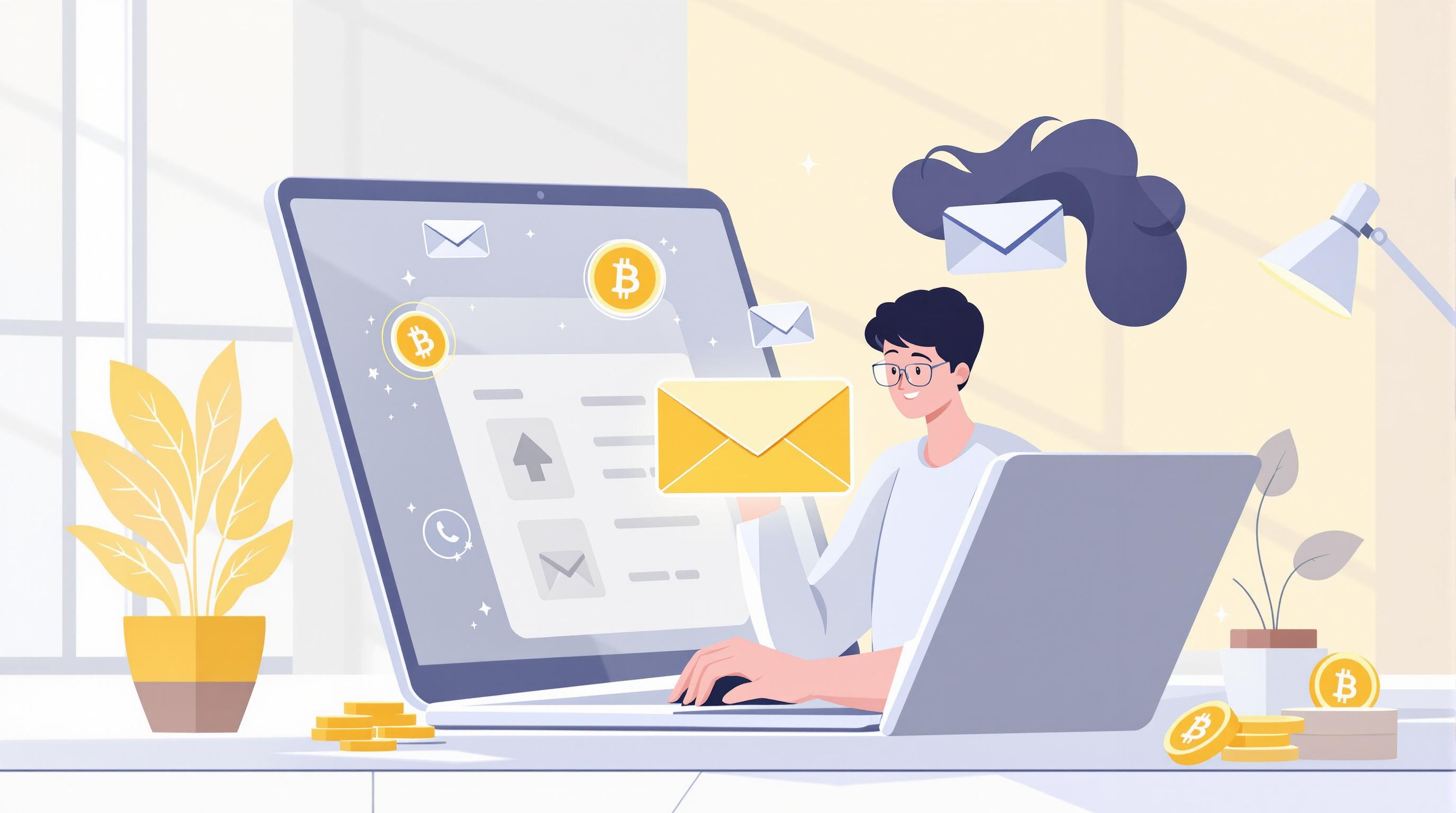
Author
Sending NFTs via Email: Step-by-Step Guide
Learn how to securely send NFTs via email, ensuring safe transfers with basic tools and essential security measures.
Sending NFTs via Email: Step-by-Step Guide
NFTs (Non-Fungible Tokens) are changing how we transfer digital assets, and now you can send them via email. Here’s a quick breakdown of how it works:
- Why Email? It’s simple, accessible to billions, and doesn’t require a crypto wallet upfront. Platforms like EtherMail make it easy and secure.
- What You Need: An NFT wallet (e.g., MetaMask), an email platform (e.g., EtherMail), and basic security measures like 2FA.
- How It Works:
- Connect your wallet to an email platform.
- Select the NFT you want to send.
- Enter the recipient’s email and confirm the transfer.
- Security Tips: Use strong passwords, enable 2FA, and verify contracts before sending.
This method is gaining traction in industries like retail (Starbucks), sports (NFL), and education (University of Georgia). With tools like EtherMail, transferring NFTs is now as easy as sending an email.
Required Tools and Setup
Before transferring NFTs via email, you'll need to set up the right tools and ensure your security measures are in place. Popular options like MetaMask and Coinbase Wallet - used by 100 million and 10 million users respectively - are widely trusted for managing digital assets.
Basic Equipment Checklist
Here’s what you’ll need to send NFTs through email:
| Component | Purpose | Popular Options |
|---|---|---|
| NFT Wallet | Manage NFT transactions | MetaMask, Coinbase Wallet |
| Email Platform | Handle NFT transfers | EtherMail |
| Blockchain Network | Process transactions | Ethereum, Polygon |
| Security Software | Protect transfers | 2FA apps, Password managers |
For zero-gas fee transfers and added security, EtherMail is a solid choice. Once you’ve identified the tools, configure your wallet and email for safe NFT management.
Setting Up Your Wallet
A secure and functional wallet is crucial for email-based NFT transfers. OpenSea recently introduced a wallet creation process (January 2024) that allows users to create self-custodied wallets with just an email address. This wallet supports transactions across nine EVM-based chains, making it ideal for email transfers.
"With our new onboarding experience and Privy's technology, you can create an OpenSea account with a self-custodied crypto wallet using your email." - OpenSea Crew
Here’s how to set up your wallet:
- Pick a trusted wallet provider.
- Use strong, unique credentials.
- Store your recovery phrase offline for safety.
- Enable support for relevant blockchain networks.
- Test the wallet with a small transaction to ensure it works.
Email Security Setup
Securing your email is just as important as setting up your wallet. NFT-related scams caused over $100 million in losses between 2021 and 2022. To avoid becoming a victim, follow these steps:
Authentication Protection
Set up two-factor authentication (2FA) and use strong, unique passwords for all accounts tied to NFT transactions.
Spam Protection
Research from Fireblocks shows that 82% of NFTs in analyzed collections were spam. Activate advanced spam filters and always verify the authenticity of senders.
Transaction Verification
Use EtherMail's two-step confirmation process to ensure no unauthorized transfers occur [1].
How to Send NFTs by Email
Follow these steps to send NFTs via email using EtherMail. Here's how you can securely complete the process.
1. Pick Your Email Platform
EtherMail bridges Web2 and Web3, offering features like:
| Feature | What It Does |
|---|---|
| Wallet-to-wallet messaging | Enables direct, secure communication |
| Token-gated content | Provides better privacy control |
| Anti-phishing protection | Strengthens security against scams |
| Smart contract support | Allows automated NFT transfers |
| Email rewards | Offers incentives for engagement |
2. Connect Your Wallet
To connect your wallet with EtherMail:
- Visit www.ethermail.io and click "Access."
- Choose one of the following options:
- Connect an existing wallet.
- Create a new self-custodial wallet using your Google or Apple login.
- Review and sign the terms to complete the connection. You can also select "Remember Me" for quicker access later.
3. Choose Your NFT
Make sure the NFT you want to send is in your wallet, on a compatible network, and that you have enough funds to cover gas fees.
4. Send the Email
EtherMail uses a two-step verification process for transfers [1]:
- Select the NFT you want to send.
- Enter the recipient's email address.
- Add any notes for the transfer.
- Perform a quick test transaction to confirm there are no gas fees.
- Finalize and confirm the transfer.
"NFTs are famously safe to buy, store and trade due to records of ownership and authenticity residing on the blockchain. However, this system relies on the owner adhering to relatively simple security measures." - SecurityNFT.com
5. Check Transfer Status
After sending, you can track the blockchain confirmation, view the status on your EtherMail dashboard, and ensure the recipient has received the NFT. If any issues arise, reach out to support at support@ethersuite.io.
sbb-itb-4ae6288
Safety and Efficiency Tips
Transfer Security Steps
Protecting your NFTs requires multiple layers of security. Start by enabling two-factor authentication (2FA) on both your wallet and EtherMail account using trusted apps like Google Authenticator. According to Elliptic, NFT theft through scams exceeded $100 million between 2021 and 2022.
Here are some key measures to safeguard your NFTs:
| Security Measure | How to Implement | Why It Matters |
|---|---|---|
| Smart Contract Verification | Use Etherscan to check the contract address | Helps avoid interacting with malicious code |
| Permission Management | Regularly review and revoke unused permissions | Prevents unauthorized contract approvals |
| Cold Storage | Use a hardware wallet | Keeps valuable NFTs offline and secure |
| Phishing Protection | Double-check email links and domain authenticity | Shields against phishing and fake websites |
After setting up these security measures, ensure each transaction is verified before proceeding.
Delivery Confirmation Guide
When transferring NFTs, always confirm the transaction with both the sender and recipient. EtherMail makes this easier by providing real-time blockchain confirmation updates. Here's a quick checklist:
- Save the transaction hash for reference.
- Monitor the recipient's wallet and get confirmation once the NFT is received.
- Keep a record of all transfer details for future reference.
These steps help ensure smooth and secure transfers.
Professional Transfer Standards
A study by Fireblocks revealed that 82% of NFTs in collections on Ethereum and Polygon were flagged as spam. To reduce risks during transfers, follow these best practices alongside EtherMail's protocols:
- Confirm the recipient's wallet is compatible with the NFT.
- Provide clear documentation for every transfer.
- Set appropriate gas fees to ensure timely processing.
- Use separate wallets for personal and business transactions.
OpenSea also reported that over 80% of NFTs in 2022 were either fake or spam. To protect your assets, verify smart contracts before any interaction and consider using a burner wallet for initial transactions with new contacts. This adds an extra layer of safety for your primary holdings.
Common Problems and Solutions
Even with careful planning, errors can occasionally occur when transferring NFTs. Here’s how to handle them effectively.
Transfer Error Fixes
NFT transfer errors can arise for several reasons. Below are some common issues and their fixes:
| Error Type | Cause | Solution |
|---|---|---|
| Execution Reverted | Transaction rejected by network | Check the NFT's availability and recipient details. |
| Gas Limit Exceeded | Insufficient gas allocation | Increase the gas limit for the transaction. |
| Pending/Stuck | Low gas fee | Adjust the gas price or unstick the transaction. |
| Dropped/Replaced | Network timing issues | Resubmit the transaction with a higher gas fee. |
For "Reverted" errors, confirm the NFT’s status on Etherscan before trying again. If you encounter an "Out of gas" message, adjust your MetaMask settings and retry with a higher gas limit. Remember, NFT transfers generally require more gas than regular transactions.
When transferring to a Gnosis Safe wallet, make sure it supports the IERC721Receiver interface to avoid failures. If problems persist, adding a fallback handler can address compatibility issues.
Wallet Issues
Wallet connection problems can also interfere with NFT transfers. To improve connectivity, try the following:
- Update your browser and wallet software to the latest version.
- Temporarily disable any security extensions.
- Use a desktop device for better connection stability.
- Confirm the network status before initiating a transfer.
- Clear your browser cache regularly.
- Check that your wallet permissions are correctly configured.
These steps can help ensure a smoother transfer process while also supporting a reliable email setup.
Email Problems
Optimizing your email setup is key to avoiding delivery issues during NFT transfers. Here’s a quick guide:
| Component | Action | Result |
|---|---|---|
| Authentication | Set up SPF, DKIM, and DMARC | Builds a stronger sender reputation. |
| Content Quality | Avoid spam triggers and use proper HTML formatting | Reduces the risk of filtering. |
| Infrastructure | Verify SMTP settings and maintain a stable connection | Ensures reliable email delivery. |
| Recipient Management | Validate email addresses and get explicit consent | Minimizes bounces and delivery failures. |
If emails are being blocked, double-check your authentication protocols. Improve your email content by avoiding common spam triggers like excessive capitalization, suspicious links, or missing plain-text versions.
For persistent issues, consider these technical fixes:
- Use an Email Address Validation API to confirm recipient addresses.
- Request delisting if your domain has been blocklisted.
- Monitor feedback loops to maintain your sender reputation.
- Ensure you have proper unsubscribe options to comply with regulations.
These strategies can help resolve common NFT transfer problems and improve the overall experience.
Summary
Main Points
Email-based NFT transfers simplify the process of delivering digital assets, especially when supported by reliable platforms. The key factors for success, both for individuals and businesses, include:
| Component | Key Focus |
|---|---|
| Platform | Prioritize ease of use and security |
| Wallet | Ensure compatibility and strong authentication |
| Process | Keep an eye on gas fees and confirm transfers |
| Security | Follow authentication and encryption best practices |
These components ensure smooth NFT transfers and provide a solid foundation for scaling business operations.
Business Implementation
Businesses can boost engagement and build communities by leveraging automated NFT airdrops and secure blockchain verification. For instance, EtherMail has already demonstrated its effectiveness, serving over 2 million verified accounts [1].
To integrate this approach successfully, consider the following:
"In today's hyper-competitive Web3 environment, airdrops can make or break a Web3 brand. The omnipresent risk of phishing during airdrop executions is a top concern for projects, with malicious actors lurking in the shadows trying to steal private keys, funds, or sensitive user data. By leveraging EtherMail's Email Airdrops, projects can rest assured that their brand reputation will be protected, and their airdrops will be carried out in the most secure and seamless way possible." - Shant Kevonian, CEO and Founder of EtherMail
Another example includes Crossmint's partnership with Mailchimp, which automates NFT minting for newsletter subscribers.
Key business advantages include:
- Automated Distribution: Seamlessly link email marketing tools with NFT minting platforms.
- Improved Security: Rely on blockchain verification and email authentication.
- Scalable Systems: Manage large-scale NFT distributions through verified platforms.
- Engagement Insights: Track user interactions and claiming rates effectively.
With NFT users projected to reach 11.64 million by 2025, businesses that adopt secure, email-based NFT transfer systems can tap into this expanding market.





